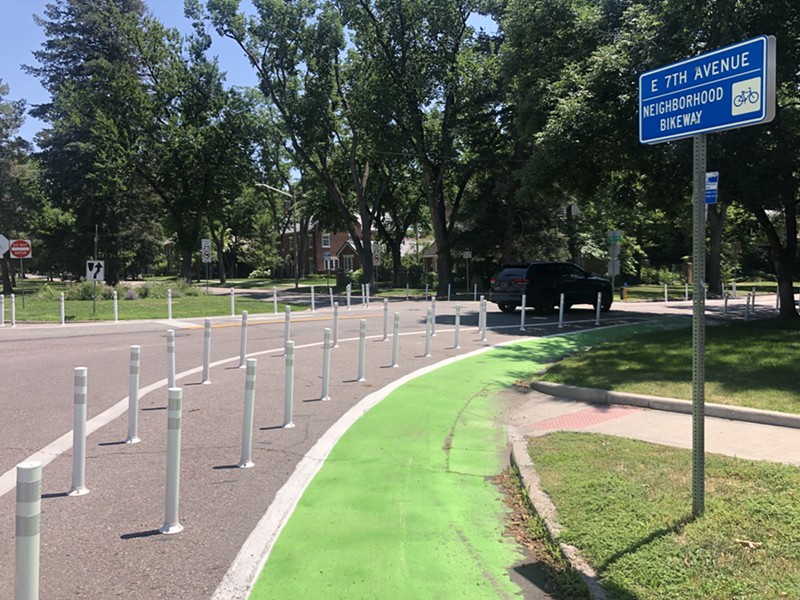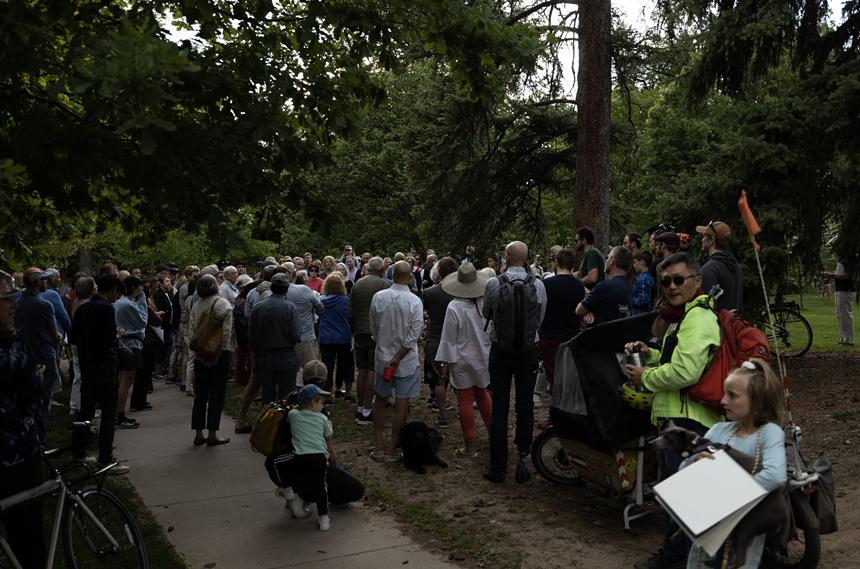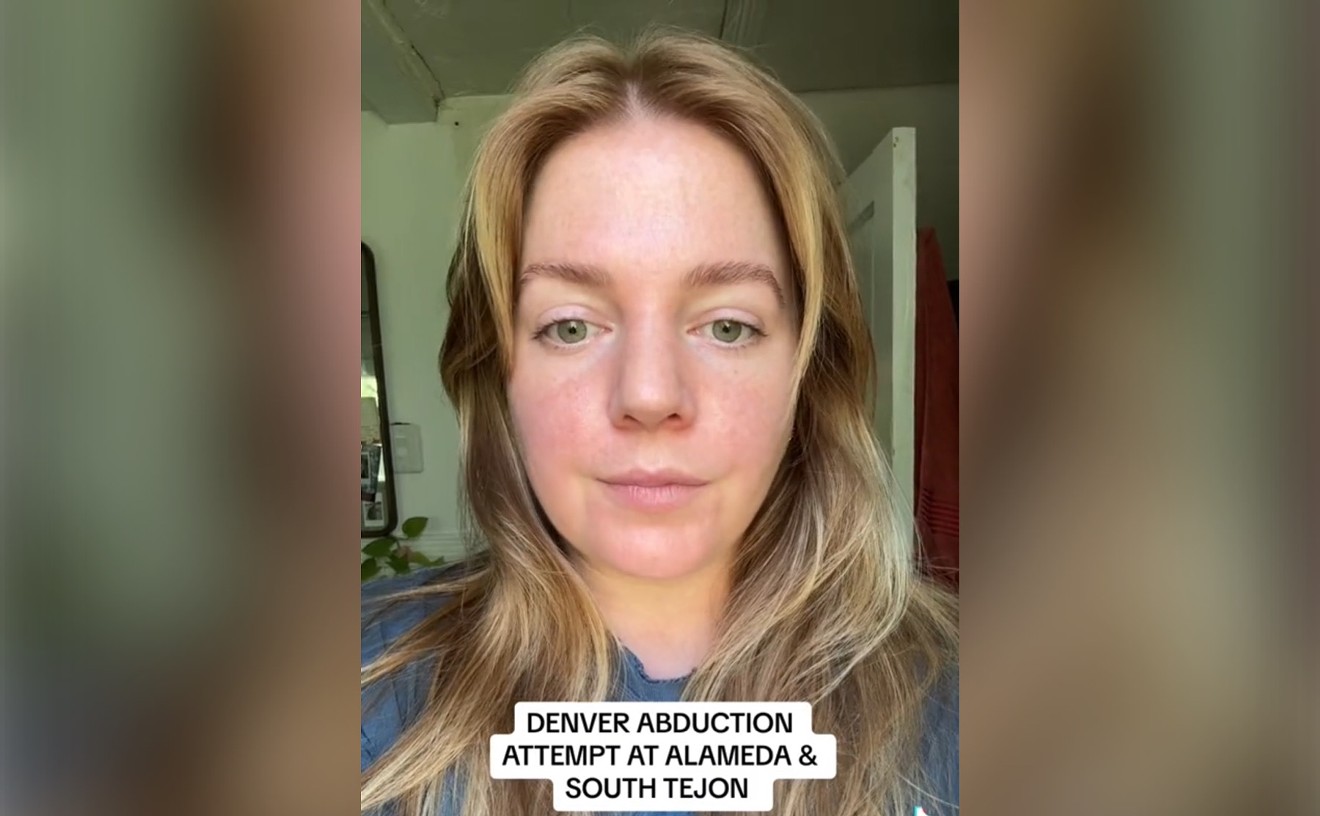Case in point: Batches of bike lane bollards, aka flexible safety poles, have sprouted up across Denver recently, along with new bicycle paths — turning once open streets into havens for cyclists and eyesores for people living nearby.
"We believe these measures are unnecessary, unsafe and negatively impact the beauty, character, and integrity of this historic neighborhood," says Kitty Koch, a resident of the Seventh Avenue Historic District, where numerous bollards have been placed.
On May 31, Koch and concerned neighbors organized a community meeting at Little Cheesman Park to discuss their concerns about the bollards along Seventh Avenue between Williams and Downing streets. The bike lanes themselves are fine, the residents say. But they're concerned about the "excessive" number of new bollards, and want to persuade Denver's Department of Transportation and Infrastructure to remove the protruding safety poles or somehow lessen their visual impact.
People who support the implementation of bollards, meanwhile, crashed the May 31 meeting. Resident Rob Toftness, a biker, recalls that things were tense at the start, "a little more heated, and then as the night went on, some folks did start having conversations," he remembers. "Eventually, there was a talking stick that got employed, and that got passed around from person to person."
Bike lanes and bike lane improvements have been cropping up all over the city in recent months. On May 24, DOTI had issued a statement celebrating its success in reaching a "major milestone in bike infrastructure" — building 137 miles of new bike lanes over the course of five years.
Bollards are put in place to increase the visibility and sense of separation between bikers and cars, according to DOTI officials, and encourage people to leave their cars behind. "The goal is to lower vehicle volumes on that stretch so it is more comfortable and attractive for biking," says DOTI spokesperson Vanessa Lacayo.
But the volume of complaints is increasing.
"We support the use of Seventh Avenue as a bikeway that balances the interests of residents, pedestrians, bicycles, and vehicles," Koch says in an emailed statement. "Our concerns relate to two main issues: (i) the number of bollards used on 7th and Williams, and (ii) the proposed installation of three unnecessary roundabouts on this section of 7th Avenue (between Downing and Williams)."
Those roundabouts are set to be built in early August, according to DOTI officials. For now, though, bollards are public enemy number one.
"We oppose the number of bollards on the southwest corner of Little Cheesman on Williams Street and 7th Avenue (88 [total] and 36 around one house alone) as excessive," writes Koch.
On July 20, District 5 City Councilwoman Amanda Sawyer facilitated a virtual meeting between Nick Williams, DOTI's deputy manager of internal and external affairs, and concerned Seventh Avenue residents who say that the bike lane infrastructure improvements not only showed up out of nowhere, but are confusing, potentially less safe — and ugly.
Williams's response: Safety first.
"Safety and traffic safety is a top priority. If anything, we're turbocharging it," he said.
Williams's response: Safety first.
"Safety and traffic safety is a top priority. If anything, we're turbocharging it," he said.
"Will DOTI make sacrifices to safety on projects like this based on community feedback?" Williams added. "Our goals are safety around this. Community feedback is an important part of this. But I will say without making blanket statements that our goal is and remains — and I don't anticipate this changing under a new administration — that Vision Zero commitment." Vision Zero was the program introduced in 2017 by then-Mayor Michael Hancock to end traffic fatality deaths by 2030.
But Williams was receptive to considering the concerns raised by residents, particularly those who believe that some of the changes at the corner of Seventh and Williams have made the intersection more dangerous by preventing cyclists from riding closer to the sidewalk in order to avoid bad drivers.
"At the Seventh and Williams intersection, few are using the right turn lane correctly. Usually, bikes go on the outside of the [bollards] and there's poor signage. It's not working," Sandra Goldhaber had said in a written comment submitted before the meeting that was read aloud. Williams's response: "We have heard that that intersection specifically is a little bit confusing, a little bit wonky, and the team is looking at that."
As for concerns that the bollards have damaged the neighborhood aesthetic of the Seventh Avenue Historic District, Wiliams said, "What is there now is theoretically temporary infrastructure. A long-term plan is to build in more hardened infrastructure; typically that is going to be more aesthetically pleasing. ... "We do not have a solid timeline on when that will happen."
After sharing a few more comments, Williams said, "If I take one thing from this meeting, it's that work needs to be done on Seventh and Williams."
In 2020, when city officials were in the planning and concept development phase, they held multiple meetings and conducted surveys with community organizations and residents in order to be as transparent as possible, according to Williams.
"Since the construction began in April, we have really tried to hit different newsletters, mailers, yard signs, dedicated phone [calls] and emails for the project," he explained. "And making sure that folks are aware of who they can talk to when they have questions about this."
According to Williams, more details about the city's transportation plans and goals can be found in the Denver Moves Everyone 2050 plan — including information about the bollards.
"An element of protection allows folks to feel safer," he said. "It also has the effect of encouraging folks to give [using the bike lanes] a shot, which is a really big part of the city's goals. ... The goal for the city has been — whether it's climate goals, whether it is traffic goals — it is to reduce the instances of single occupancy vehicles and increase the instances of bicycles and pedestrians. And how we do that is make it a favorable option.
"If it is more comfortable, you are more apt to do that," Williams concluded.













